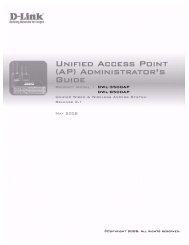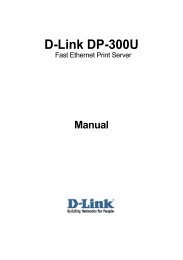- Page 1 and 2:
D-Link DES-3526/DES-3526DC Managed
- Page 3 and 4:
Table of Contents Preface..........
- Page 5 and 6:
QoS................................
- Page 7 and 8:
Download Configuration File .......
- Page 9 and 10:
DES-3526 / DES-3526DC Fast Ethernet
- Page 11 and 12:
DES-3526 / DES-3526DC Fast Ethernet
- Page 13 and 14:
Introduction Gigabit Ethernet Techn
- Page 15 and 16:
DES-3526 / DES-3526DC Fast Ethernet
- Page 17 and 18:
LED Indicators DES-3526 / DES-3526D
- Page 19 and 20:
DES-3526 / DES-3526DC Fast Ethernet
- Page 21 and 22:
Installation Package Contents Befor
- Page 23 and 24:
DES-3526 / DES-3526DC Fast Ethernet
- Page 25 and 26:
Connecting The Switch DES-3526 / DE
- Page 27 and 28:
DES-3526 / DES-3526DC Fast Ethernet
- Page 29 and 30:
DES-3526 / DES-3526DC Fast Ethernet
- Page 31 and 32:
Password Protection DES-3526 / DES-
- Page 33 and 34:
MIBs DES-3526 / DES-3526DC Fast Eth
- Page 35 and 36:
DES-3526 / DES-3526DC Fast Ethernet
- Page 37 and 38:
DES-3526 / DES-3526DC Fast Ethernet
- Page 39 and 40:
DES-3526 / DES-3526DC Fast Ethernet
- Page 41 and 42:
DHCP Manual Subnet Mask Default Gat
- Page 43 and 44:
MAC Address Aging Time DES-3526 / D
- Page 45 and 46:
DES-3526 / DES-3526DC Fast Ethernet
- Page 47 and 48:
To configure a mirror port: DES-352
- Page 49 and 50:
DES-3526 / DES-3526DC Fast Ethernet
- Page 51 and 52:
DES-3526 / DES-3526DC Fast Ethernet
- Page 53 and 54:
MAC Notification Port Settings DES-
- Page 55 and 56:
DES-3526 / DES-3526DC Fast Ethernet
- Page 57 and 58:
The following parameters can be set
- Page 59 and 60:
DES-3526 / DES-3526DC Fast Ethernet
- Page 61 and 62:
DES-3526 / DES-3526DC Fast Ethernet
- Page 63 and 64:
Parameter Description DES-3526 / DE
- Page 65 and 66:
DES-3526 / DES-3526DC Fast Ethernet
- Page 67 and 68:
DES-3526 / DES-3526DC Fast Ethernet
- Page 69 and 70:
DES-3526 / DES-3526DC Fast Ethernet
- Page 71 and 72:
Multicast Port Filtering Mode DES-3
- Page 73 and 74:
DES-3526 / DES-3526DC Fast Ethernet
- Page 75 and 76:
DES-3526 / DES-3526DC Fast Ethernet
- Page 77 and 78:
DES-3526 / DES-3526DC Fast Ethernet
- Page 79 and 80:
DES-3526 / DES-3526DC Fast Ethernet
- Page 81 and 82:
GVRP Setting DES-3526 / DES-3526DC
- Page 83 and 84:
DES-3526 / DES-3526DC Fast Ethernet
- Page 85 and 86:
DES-3526 / DES-3526DC Fast Ethernet
- Page 87 and 88:
DES-3526 / DES-3526DC Fast Ethernet
- Page 89 and 90:
DES-3526 / DES-3526DC Fast Ethernet
- Page 91 and 92:
DES-3526 / DES-3526DC Fast Ethernet
- Page 93 and 94:
The following parameters can be set
- Page 95 and 96:
DES-3526 / DES-3526DC Fast Ethernet
- Page 97 and 98:
from GMT in +/- HH:MM DES-3526 / DE
- Page 99 and 100:
DES-3526 / DES-3526DC Fast Ethernet
- Page 101 and 102:
DES-3526 / DES-3526DC Fast Ethernet
- Page 103 and 104:
DES-3526 / DES-3526DC Fast Ethernet
- Page 105 and 106:
DES-3526 / DES-3526DC Fast Ethernet
- Page 107 and 108:
DES-3526 / DES-3526DC Fast Ethernet
- Page 109 and 110:
DES-3526 / DES-3526DC Fast Ethernet
- Page 111 and 112: DES-3526 / DES-3526DC Fast Ethernet
- Page 113 and 114: Authenticator DES-3526 / DES-3526DC
- Page 115 and 116: 802.1X Client 802.1X Client DES-352
- Page 117 and 118: DES-3526 / DES-3526DC Fast Ethernet
- Page 119 and 120: DES-3526 / DES-3526DC Fast Ethernet
- Page 121 and 122: DES-3526 / DES-3526DC Fast Ethernet
- Page 123 and 124: This window displays the following
- Page 125 and 126: DES-3526 / DES-3526DC Fast Ethernet
- Page 127 and 128: DES-3526 / DES-3526DC Fast Ethernet
- Page 129 and 130: DES-3526 / DES-3526DC Fast Ethernet
- Page 131 and 132: DHCP Agent Information Option 82 Ch
- Page 133 and 134: DES-3526 / DES-3526DC Fast Ethernet
- Page 135 and 136: DES-3526 / DES-3526DC Fast Ethernet
- Page 137 and 138: DES-3526 / DES-3526DC Fast Ethernet
- Page 139 and 140: DES-3526 / DES-3526DC Fast Ethernet
- Page 141 and 142: DES-3526 / DES-3526DC Fast Ethernet
- Page 143 and 144: Parameter Description DES-3526 / DE
- Page 145 and 146: Local Enable Password DES-3526 / DE
- Page 147 and 148: DES-3526 / DES-3526DC Fast Ethernet
- Page 149 and 150: DES-3526 / DES-3526DC Fast Ethernet
- Page 151 and 152: SSH Algorithm DES-3526 / DES-3526DC
- Page 153 and 154: DES-3526 / DES-3526DC Fast Ethernet
- Page 155 and 156: Traps DES-3526 / DES-3526DC Fast Et
- Page 157 and 158: The following parameters can set: P
- Page 159 and 160: DES-3526 / DES-3526DC Fast Ethernet
- Page 161: DES-3526 / DES-3526DC Fast Ethernet
- Page 165 and 166: The following field can be set: Par
- Page 167 and 168: DES-3526 / DES-3526DC Fast Ethernet
- Page 169 and 170: UMB Cast (RX) DES-3526 / DES-3526DC
- Page 171 and 172: DES-3526 / DES-3526DC Fast Ethernet
- Page 173 and 174: DES-3526 / DES-3526DC Fast Ethernet
- Page 175 and 176: The following fields may be set or
- Page 177 and 178: Parameter Description DES-3526 / DE
- Page 179 and 180: DES-3526 / DES-3526DC Fast Ethernet
- Page 181 and 182: DES-3526 / DES-3526DC Fast Ethernet
- Page 183 and 184: DES-3526 / DES-3526DC Fast Ethernet
- Page 185 and 186: DES-3526 / DES-3526DC Fast Ethernet
- Page 187 and 188: Maintenance TFTP Services Switch Hi
- Page 189 and 190: DES-3526 / DES-3526DC Fast Ethernet
- Page 191 and 192: DES-3526 / DES-3526DC Fast Ethernet
- Page 193 and 194: DES-3526 / DES-3526DC Fast Ethernet
- Page 195 and 196: DES-3526 / DES-3526DC Fast Ethernet
- Page 197 and 198: DES-3526 / DES-3526DC Fast Ethernet
- Page 199 and 200: DES-3526 / DES-3526DC Fast Ethernet
- Page 201 and 202: DES-3526 / DES-3526DC Fast Ethernet
- Page 203 and 204: Commander Switch Icon DES-3526 / DE
- Page 205 and 206: Candidate Switch Icon DES-3526 / DE
- Page 207 and 208: Group DES-3526 / DES-3526DC Fast Et
- Page 209 and 210: DES-3526 / DES-3526DC Fast Ethernet
- Page 211 and 212: Cables and Connectors DES-3526 / DE
- Page 213 and 214:
Glossary DES-3526 / DES-3526DC Fast
- Page 215 and 216:
DES-3526 / DES-3526DC Fast Ethernet
- Page 217 and 218:
This limited warranty provided by D
- Page 219 and 220:
Trademarks: D-Link is a registered
- Page 221 and 222:
D-Link Europe Limited Product Warra
- Page 223 and 224:
D-Link Europe Limited Produktgarant
- Page 225 and 226:
D-Link Europe a limité la garantie
- Page 227 and 228:
Garantía limitada del producto D-L
- Page 229 and 230:
D-Link Europe Termini di Garanzia d
- Page 231 and 232:
Technical Support You can find soft
- Page 233 and 234:
Technical Support You can find soft
- Page 235 and 236:
Technical Support You can find soft
- Page 237 and 238:
Technical Support You can find upda
- Page 239 and 240:
Asistencia Técnica D-Link Latin Am
- Page 241 and 242:
友冠技術支援 台灣地區用
- Page 243 and 244:
Technical Support You can find soft
- Page 245 and 246:
Assistance technique Vous trouverez
- Page 247 and 248:
Supporto tecnico Gli ultimi aggiorn
- Page 249 and 250:
Pomoc techniczna Najnowsze wersje o
- Page 251 and 252:
Technikai Támogatás Meghajtó pro
- Page 253 and 254:
Teknisk Support Du finder software
- Page 255 and 256:
技术支持 办公地址:北京市
- Page 257:
Registration Card (All Countries an

















